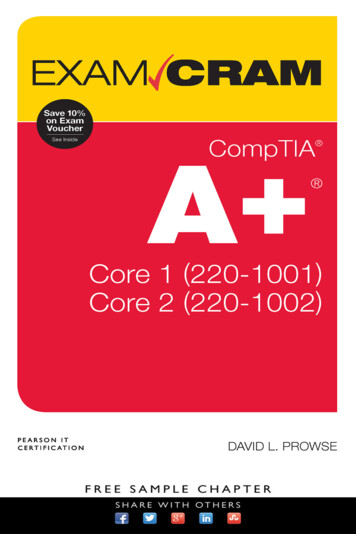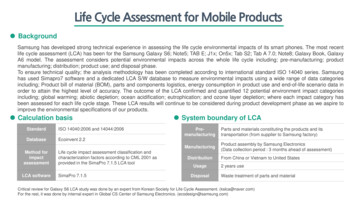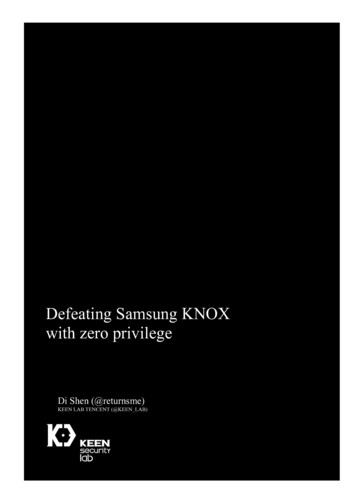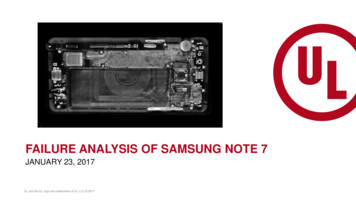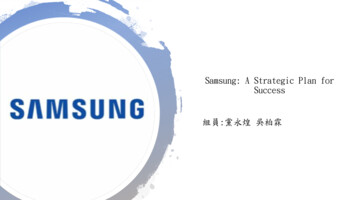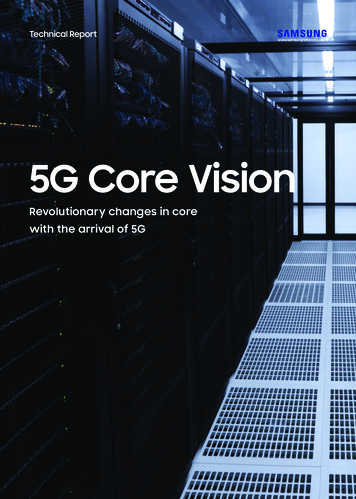
Transcription
Technical Report5G Core VisionRevolutionary changes in corewith the arrival of 5G1
Contents02Introduction043GPP 5G Standard06Samsung 5G Core Overview09Samsung Cloud Native 5G Core12Key Features Supporting Various 5G Use Cases14Samsung’s 5G Innovation g 5G Core Vision5G Core Network Design Principle5G Deployment OptionsSamsung 5G Strategy4G to 5G Migration PlanSamsung 5G Common Core PortfolioSamsung 5G Network Automation ArchitectureSamsung Cloud Native 5G CoreNetwork SlicingMECIntroductionUntil now, mobile communication technologies have evolved to focus on accelerating radio data rate while mobilecommunication networks acted as dummy pipes to deliver user data securely and quickly. 5G network provides radioconnections enabling not only ultra-high speed but also lower latency, higher reliability and massive connectivity,transforming into a platform integrating various services beyond a transport pipe by connecting mobile phones, sensors,autonomous robots and automobiles.As of February 2019, Korea has LTE penetration rate of over 80%, and its total traffic volume reached 373.PB, or 7.6 GBper individual user. With a cell capacity ten times more than LTE, the continued construction of more cell sites and theacceleration of the Internet of Small Things, the total volume of data traffic for 5G is expected to increase exponentially.5G networks should be able to process an ever-increasing volume of data more cost-effectively, and at the same timeprovide various services on a single infrastructure with high reliability at a faster speed. As such, IT technologies such asNetwork Function Virtualization (NFV) and cloud have been introduced into 5G Core, which completely overhauled the wayof creating, deploying, operating and managing of network services. In particular, cloud native architecture based on microservices and containers is considered as the most attractive technology best suited to support faster service launch andnetwork operation automation.Korea commenced the 5G era with the launch of the world's first mobile 5G network in December 2018, andcommercialization of the world's first smartphone-based mobile 5G service in April 2019. Samsung has introduced 5GNon-Standalone (NSA) Core with Control and User Plane Separation (CUPS)-based vEPC in Korea, and is concentratingon the development of cloud native 5G Core for 5G Standalone (SA) commercialization.This white paper will review the vision and strategy of Samsung 5G Core, the architecture of Samsung Cloud Native 5GCore, and Samsung Network Automation Platform that automatically serves to create, deploy, operate and manage networkservices. Network slicing that provides dedicated networks according to service characteristics and Multi-access EdgeComputing (MEC) that processes application services at the edge of a network are becoming new revenue streams fortelecom operators. So, we will discuss Samsung network slicing and MEC solutions that Samsung Cloud Native 5G Coresupports.2
Samsung 5G Core Vision5G networks, with its implementation of networkservices as software, need to be optimized forNFV and cloud. Samsung 5G Core, with its cloudnative core, is designed to take full advantage ofthe cloud, acting as the key enabler for the rapidrealization of 5G innovation. Figure 1-1 shows thevision of Samsung 5G Core. Defined as 'FAST',the vision of Samsung 5G Core aims to be aFlexible, Agile, Scalable and Tunable network.FlexibleSamsung 5G Core flexibly adds new services andconfigures the network on a shared infrastructure.It also allows an elastic scalability of networkfunctions at CP/UP and micro-service levelaccording to the 5G service profiles.AgileSamsung 5G Core shortens the serviceimplementation time from hours to minutes anddelivers faster time-to-market (TTM) for newservices from months to days.ScalableSamsung 5G Core is scalable rapidly and highlywith telco-grade reliability. This further improvesthe performance of the distributed user plane andprovides telco-grade cloud native control planeperformance.TunableSamsung 5G Core not only provides bothcustomized and optimized networks for various 5Gservices but also quickly adapts and optimizes thenetwork according to operation conditions. It alsosupports cost-efficient migration from 4G to 5Gbased on access agnostic common core. Flexibly add new service and configurenetwork on a shared infrastructure Elastically scale (CP/UP, Micro-servicelevel) according to 5G service profiles Reduced service implementation Time(Hours Minutes) Faster TTM for new service(Months Days) Rapidly & highly scalable withtelco-grade reliability Higher UP performance Telco-grade cloud native CPPerformance Network tailored & optimized for a widerange of 5G services Fast adaptation & optimizationaccording to operation conditions Cost efficient 4G to 5G migrationbased on common coreFigure 1. Samsung 5G Core Vision : FAST3
3GPP 5G Standard5G Core Network Design PrincipleThe emergence of cloud forced the architecture of 5G Core to undergo revolutionary changes. The underlying drivers behind 5GCore innovation are SBA, Stateless, Network Slicing and Common Core.Service-Based Architecture (SBA)The SBA architecture, fundamental in5G's move towards the cloudization, isadopted by the control plane of 5G Core.A network function (NF) constitutes ofsmall service units called NF services(micro-services). Adding a new servicewill not impact existing ones, makingscalability simple. The interactionbetween two NFs depends on howa service is processed. Unlike thetraditional architecture where differentpoint-to-point (P2P) interfaces aredefined between network entities, in theSBA architecture, NFs can request andprovide a service using a Service-BasedInterface (SBI), a uniform interfacebased on HTTP/2. Services can bereused among NFs, and new featurescan be introduced easily using theuniform interface. NRF is used when anNF registers its NF profile or discoversservices. The interactions between thecontrol plane and user plane will usetraditional P2P interface.StatelessExisting NE sustains its UE contextinformation (state) as long as the usersession is established. 5G Core NFsdo not keep UE context but store it ina separate DB defined as a standardNF. Any NF can store unstructureddata in UDSF, and structured data fromUDM, PCF and NEF is saved in UDR.'Stateless' stems from the cloud conceptthat process and storage are separated,which simplifies NF functions and bootsscalability.Network slicingNetwork slicing is a technologythat separates a shared physicalnetwork infrastructure into multiplelogical networks with different servicecharacteristics, known as slices.Each slice would group the neededNFs for a particular service to offer adedicated network. This allows fastbuildup of a network for a new servicewithout impacting the existing services,reducing time-to-market and improvingoperational efficiency. Network SliceSelection Function (NSSF), known asa new NF, is added to provide networkslicing in 5G Core.Common CoreIn 5G Core, 3GPP access such asLTE and NR and non-3GPP accessincluding Wi-Fi and fixed broadband canbe integrated via a common interface.A unified authentication process issupported for multi-RAT access.Figure 2-1. 5G Core Network Design Principle4
5G Deployment OptionsThe evolution from LTE to 5G can vary depending on themobile operator’s network status and strategy. Figure 2-2depicts the 5G deployment options.by adopting NR.Because the NR characteristics are limited,the 5G use cases are not fully exploitable, but the userthroughput can be greatly improved.UE signaling is processed by LTE in New Radio (NR) NSA andby 5G NR in NR SA. Since 5G coverage is very limited in theinitial stage of 5G deployment, the UE signaling is processedby LTE with nationwide coverage, and as 5G coverageexpands, the UE signaling is processed by NR. Therefore,existing LTE networks will evolve into NR SA through NRNSA.Option 7 upgrades LTE to eLTE and introduces 5G Core. TheNR characteristics are also limited, but it can support networkslicing and deploy hot spot with above 6GHz (A6G) NR.NR NSA has Option 3 that re-uses EPC, and Option 7, whichintroduces 5G Core. Option 3 can quickly commercialize 5GSamsung 5G Networks support NSA Option 3 family andOption 4/7 family co-existence and can support optimal 5Gdeployment for mobile operators.Option 4 will be possible as the coverage of below 6GHz (B6G)NR expands nationwide, allowing the full feature set of NR aswell as 5G specific services such as low latency services.Figure 2-2. 4G to 5G Deployment Options5
Samsung 5G Core OverviewSamsung 5G Core StrategyFigure 3-1. Samsung 5G Core StrategyFigure 3-1 illustrates the Samsung 5G Core strategy. The key strategy for achieving the vision of Samsung 5G Core is definedas Cloud Native, Network Slicing, Common Core and Automation.Cloud NativeSamsung 5G Core isdeveloped and verified in acloud native environment.A cloud native environmentbased on micro-services,containers and statelessarchitectures will boost theefficiency of developmentand verification of 5G CoreNF, and automate serviceupgrades and deploymentsfor better operationalefficiency.6Network SlicingNetwork slicing feature willallocate dedicated resourcesand network for each service,which will minimize the impacton the existing services whileaccelerating the launch of anew service. It allows a flexibleresponse to the changes inservice demand and acquisition ofnew userbase through adoptionacross vertical industries.Common CoreSamsung 5G Coreenables the integration ofvarious types of accessnetworks.AutomationSamsung 5G Core providesa Network AutomationPlatform, which automaticallyresponds to any changesin 5G Network such asoperation, upgrades andmonitoring, thereby boostingoperational efficiency. ThePlatform is also able toautomatically create 5Gservices, such as networkservices and network slices.
4G to 5G Migration PlanAn LTE network operator will be able to choose from variousmigration paths to the 5G network depending on the networkconfiguration of the operator, 5G network construction plan,5G subscriber penetration, etc. Figure 3-2 outlines the smoothmigration plan from 4G to 5G by Samsung 5G Core.5G Ready EPCSamsung LTE Core is already virtualized and provides aCUPS architecture with separate CP and UP, a basic featureof 5G, for quick and easy support of the introduction of 5Gnetwork.Introduction of 5G NSA CoreThe initial stage of 5G network will be 5G NSA, where 5Gbase stations are introduced to the existing LTE network. The5G NSA Core can be implemented by partially upgradingexisting EPC SWs to support LTE-NR dual connectivityand charging for 5G base stations. In NSA mode, LTE basestations operate as the signaling anchors, and 5G basestations are used only as data paths. Therefore, although 5Guse cases are limited, the introduction of 5G base stations canachieve significant user throughput enhancement. Thanks toits CUPS architecture, Samsung EPC is easy to evolve into5G SA Core.Introduction of 5G SA Core5G SA will adopt 5G Core, which consists of new 5G CoreNFs and supports SBA architecture. The existing EPC NEssuch as GW-C, GW-U, HSS and PCRP will be upgraded to5G Core NFs, SMF, UPF, UDM and PCF, respectively, whileAMF, NRF, NSSF, NEF and UDF will be newly introduced.With the introduction of 5G Core and 5G base stations assignaling anchors, 5G use cases can take full advantage of5G characteristics. Interworking/integration between 5G Coreand existing EPC is affected by factors like 5G subscribergrowth, service proliferation and operator policies. Samsung5G Core provides a comprehensive migration plan, including(i) separate operation of 5G Core from the existing EPC, (ii)interworking via N26 interface, and (iii) common core thatintegrates both 4G, 5G (NSA and SA) and even Wi-Fi.Figure 3-2. 4G to 5G Migration Plan7
Samsung 5G Common Core PortfolioFigure 3-3. Samsung 5G Common Core PortfolioSamsung 5G common core portfolio constitutes four solutions, as shown in Figure 3-3 below. Each solution supportstightly-coupled feature set and telco-grade reliability.5G Business Enablementsupports NFs for charging,policing and network slicing5G Service Supportsupports NFs for networkinformation and exposureMobility & Connection Controlsupports NFs forauthentication, database andsignaling processingSamsung Cloud Native 5G CoreSamsung 5G Network Automation ArchitectureFigure 4-1. Samsung 5G Network Automation Architecture8Session & Data Processingsupports NFs for sessioncontrol and data trafficprocessingwith embedded DPIfunctions
Telco's infrastructure has evolved to consist embedded HWs,which are individual NEs. With the adoption of NFV and cloud,it is shifting to virtualized cloud infrastructure where networkservices are created automatically on a general-purpose serverat a low cost. Furthermore, the infrastructure is evolving intoa cloud native architecture as virtualization technology movesaway from heavyweight virtual machine (VM) to lightweightcontainers. In a cloud native architecture, automatic creationand deployment of network services will warrant more efficientnetwork operation and management.Figure 4-1 illustrates Samsung 5G Network Automationarchitecture based on the Samsung Network AutomationPlatform and Samsung 5G Network. Samsung NetworkAutomation Platform consists of four key components: aCentralized Orchestration for E2E orchestration, a NetworkSlice Manager (NSM) for network slice management, aCentralized Operation for EMS management, and a CentralizedAnalytics for data collection and analysis. Samsung 5G Networksupports hybrid virtualization using both VM and container andprovides network slices depending on service characteristics.Samsung 5G Network Automation architecture provides 5Gservices by integrating RAN, Core and MEC centering onSamsung Network Automation Platform. The architecturealso simplifies and automates the operation of Sam
Samsung has introduced 5G Non-Standalone (NSA) Core with Control and User Plane Separation (CUPS)-based vEPC in Korea, and is concentrating on the development of cloud native 5G Core for 5G Standalone (SA) commercialization. This white paper will review the vision and strategy of Samsung 5G Core, the architecture of Samsung Cloud Native 5G
